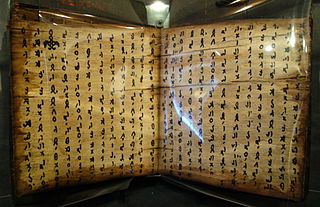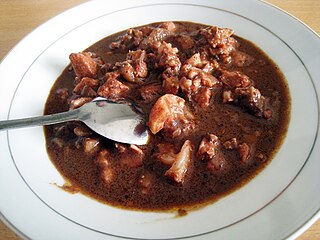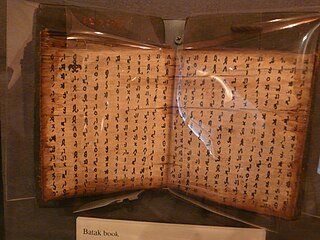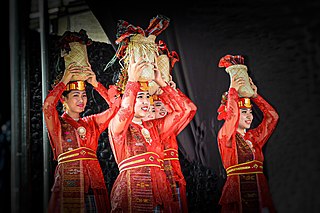
Batak is a collective term used to identify a number of closely related Austronesian ethnic groups predominantly found in North Sumatra, Indonesia, who speak Batak languages. The term is used to include the Karo, Pakpak, Simalungun, Toba, Angkola, and Mandailing, related ethnic groups with distinct languages and traditional customs (adat).

The Batak are one of about 140 indigenous peoples of the Philippines. They are located in the northeastern portions of Palawan, a relatively large island in the southwest of the archipelago. Since ancient times, the Batak have inhabited a series of river valleys along the coastline of what is today Puerto Princesa City.

The Batak languages are a subgroup of the Austronesian languages spoken by the Batak people in the Indonesian province of North Sumatra and surrounding areas.

The Mandailing is an ethnic group in Sumatera, Indonesia that is commonly associated with the Batak people. They are found mainly in the northern section of the island of Sumatra in Indonesia. They came under the influence of the Kaum Padri who ruled the Minangkabau of Tanah Datar. As a result, the Mandailing were influenced by Muslim culture and converted to Islam. There are also a group of Mandailing in Malaysia, especially in the states of Selangor and Perak. They are closely related to the Angkola and Toba.
Batak Rabit is a small town in Hilir Perak District, Perak, Malaysia. The town is located near Teluk Intan town. It was named after Batak mercenaries that comes from the Batak District in Sumatra that was brought by Raja Laut during a Selangor civil war had their ears and noses grossly bangled that hung out.
The term Parmalim or malim describes the followers of the Malim religion, the modern form of the traditional Batak religion. People who are not familiar with the Batak language may erroneously assume Parmalim is the name of the religion rather than its practitioners.
Marga is a term in Batak societies referring to a clan name. The term is derived either from the Sanskrit varga, meaning company, party, or group, or, more likely, from the Sanskrit marga, meaning 'road, way or path', referring to a people of 'one origin'.

The Sultanate of Deli was a 1,820 km² Malay state in east Sumatra founded in 1630. A tributary kingdom from 1630 it was controlled by various Sultanates until 1814, when it became an independent sultanate and broke away from the Sultanate of Siak.

Karo, referred to in Indonesia as Bahasa Karo, is an Austronesian language that is spoken by the Karo people of Indonesia. It is used by around 600,000 people in North Sumatra. It is mainly spoken in Karo Regency, southern parts of Deli Serdang Regency and northern parts of Dairi Regency, North Sumatra, Indonesia. It was historically written using the Batak alphabet which is descended from the Brahmi script of ancient India by way of the Pallava and Old Kawi scripts, but nowadays only a tiny number of Karo can write or understand the script, and instead the Latin script is used.

Simalungun Regency is a regency in North Sumatra, Indonesia. Its seat was formerly at Pematangsiantar, but this city was in 1986 separated from the Regency and made into an independent city (kota), although it remains geographically surrounded by the regency, whose new administrative seat is at Raya. The regency now covers an area of 4,372.5 square kilometres, and at the 2010 census it had a population of 817,720; at the 2020 Census this had risen to 990,246, of whom 497,314 were male and 492,932 were female; the official estimate as at mid 2022 was 1,021,615.
Khadka, anciently called as Khaḍka, is a surname of Khas/Chhetri caste. Khadga was an ancient Paikelā (warrior) rank along with Thāpā, Rānā and Buḍhā chhetri.

Mandailing or Mandailing Batak is an Austronesian language spoken in Indonesia, the northern island of Sumatra. It is spoken mainly in Mandailing Natal Regency, North Padang Lawas Regency, Padang Lawas Regency, and eastern parts of Labuhan Batu Regency, North Labuhan Batu Regency, South Labuhan Batu Regency and northwestern parts of Riau Province. It is written using the Latin script but historically used Batak script.

The Simalungun people are an ethnic group in North Sumatra, considered one of the Batak peoples. Simalungun people live mostly in Simalungun Regency and the surrounding areas, including the city of Pematang Siantar, an autonomous city, but previously part of Simalungun Regency.

Patuan Bosar SinambelaginoarOmpu Pulo Batu, better known as Si Singamangaraja XII, was the last priest-king of the Batak peoples of north Sumatra. In the course of fighting a lengthy guerrilla war against the Dutch colonisation of Sumatra from 1878 onwards, he was killed in a skirmish with Dutch troops in 1907. He was declared a National Hero of Indonesia in 1961 for his resistance to Dutch colonialism.

Toba Batak people are the largest ethnic group of the Batak peoples of North Sumatra, Indonesia. The common phrase of ‘Batak’ usually refers to the Batak Toba people. This mistake is caused by the Toba people being the largest sub-group of the Batak ethnic and their differing social habit has been to self-identify as merely Batak instead of ‘Toba’ or ‘Batak Toba’, contrary to the habit of the Karo, Mandailing, Simalungun, Pakpak communities who commonly self-identify with their respective sub-groups.

Saksang or sa-sang is a savory, spicy Indonesian dish from the Batak people. It is made from minced pork or dog meat stewed in its blood, coconut milk and spices; including kaffir lime and bay leaves, coriander, shallot, garlic, chili pepper and Thai pepper, lemongrass, ginger, galangal, turmeric and andaliman.
Batak is an Austronesian language spoken by the Batak people on Palawan Island in the Philippines. It is sometimes disambiguated from the Batak languages as Palawan Batak.

A Piso Halasan is a traditional sword of the Batak people from North Tapanuli Regency, North Sumatra, Indonesia.

Batak mythology is the original belief that was once adopted by the Batak people of North Sumatra, Indonesia, namely before the arrival of Protestant, Catholic, or Islamic religions. There are various tarombo versions written on pustaha which historians study, but generally refer to the figures below.

Tandok dance is a traditional Batak dance originating from the North Sumatra, Indonesia. This dance tells about the activities of harvesting rice using tandok carried out by mothers in the fields. In addition, this dance also contains the importance of family values between each other.















